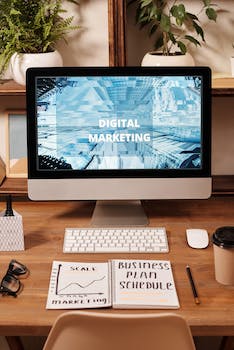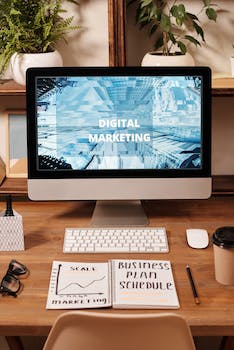Archive
PPC Advertising vs. SEO: Which is Right for Your Business?
As a business owner, one of the biggest challenges is deciding how to allocate your marketing budget. Two of the most common options are pay-per-click advertising (PPC) and search engine optimization (SEO). Each has its pros and cons, so I wanted to share my thoughts on which may be right for your business.

PPC advertising, like Google Ads, is a fast way to drive traffic to your website. You can launch a PPC campaign quickly and see results right away. However, it can be expensive, especially if you’re in a competitive industry. The traffic also tends to be lower quality since people are just clicking on an ad. PPC requires ongoing management and optimization to get the best results.
SEO takes longer to ramp up but can provide high-quality, targeted traffic for the long run. It involves optimizing your website to rank higher in the organic search results on Google and other search engines. The traffic SEO generates is very targeted, since people are searching for what you offer. However, SEO can take 6-18 months to really start driving significant traffic. It also requires ongoing work to maintain and improve your rankings.
For most businesses, a combination of PPC and SEO is the best approach. PPC can drive traffic and revenue in the short term while your SEO efforts start to pay off in the long run. If budget is a concern, I would focus on nailing your on-page SEO first before investing heavily in PPC. On-page SEO includes optimizing your page titles, content, internal linking, and more.
In summary, think of PPC as a sprint and SEO as a marathon. For the best results, you need both. Determine how much you can afford to spend on paid advertising and focus the rest of your efforts on SEO. With time and consistency, you’ll have both short-term and long-term traffic strategies working together to grow your business.
This post may contain affiliate links, where I may receive a small commission if you purchase something through following the link at no cost to you.
The Importance of Keyword Research in Your PPC Strategy
Keyword research is one of the most important parts of any pay-per-click advertising strategy. As an advertiser, you need to make sure you’re targeting the right keywords – ones that are relevant to your business and ones that people are actually searching for.
When I first started advertising, I made the mistake of just guessing at what keywords might be good to target. I ended up wasting a lot of money on irrelevant clicks and didn’t get many conversions or sales. Once I started doing proper keyword research, my PPC campaigns became much more effective.

There are a few ways to research good PPC keywords:
- See what keywords your competitors are targeting. You can use tools like SEMrush, Ahrefs, or SpyFu to analyze competitors’ paid search campaigns. Look for keywords that are relevant to your business and seem to be driving a lot of traffic for them.
- Check search volume and competition for keywords. Use the Google Keyword Planner or another tool to see how many people are searching for different keywords each month and how competitive those keywords are. Focus on keywords with high search volume and low-to-medium competition.
- Look at your website analytics to see what keywords people are already using to find your site. The keywords that are already driving organic traffic to your site are likely to also perform well as PPC keywords.
- Brainstorm keyword lists based on your products, services, industry, location, etc. Come up with lists of possible keywords, then check the search volume and competition to determine good options.
- Look for long-tail keyword variations. Long-tail keywords, like “low cost small business marketing consulting services”, tend to have lower competition and higher conversion rates.
Keyword research does take time, but it’s time well spent. By targeting the right keywords in your PPC campaigns, you’ll waste less money and see better results. Your ads will reach more interested audiences, you’ll get more clicks and conversions, and you’ll ultimately make more sales. So do your keyword homework – it will really pay off!
This post may contain affiliate links, where I may receive a small commission if you purchase something through following the link at no cost to you.
Optimizing Your Conversion Funnel: Tips and Tricks
As a website owner, you want to convert as many visitors as possible into paying customers. However, achieving this goal can be challenging, especially if you don’t have a well-optimized conversion funnel. In this blog post, I’m going to share some tips and tricks that can help you optimize your conversion funnel and increase your website’s conversion rate.
1. Use a Clear Call-to-Action
A clear call-to-action (CTA) is essential to guide your visitors through the conversion funnel. Make sure your CTA is prominent and stands out from the rest of your content. A good CTA should be specific, action-oriented, and relevant to what you’re offering. For example, if you’re selling a product, your CTA should say something like “Buy Now” or “Add to Cart.”

2. Simplify Your Forms
Long and complicated forms can be a major turn-off for your visitors. Keep your forms simple and straightforward, and only ask for the essential information. The shorter your form, the higher the chances that visitors will complete it. If you need additional information, you can always ask for it later, once the visitor has become a customer.
3. Optimize Your Landing Pages
Your landing pages are the first impression your visitors get of your website. Make sure they’re optimized for conversions by using clear and concise headlines, persuasive copy, and eye-catching visuals. Your landing page should also be relevant to the visitor’s search query, so make sure you’re targeting the right keywords.
4. Provide Social Proof
Social proof is a powerful tool that can help increase your website’s conversion rate. Include customer reviews, testimonials, and case studies on your website to show potential customers that others have had a positive experience with your product or service. Social proof can help build trust and credibility, which are essential for converting visitors into customers.
5. Offer Incentives
Incentives can be a powerful motivator for visitors to take action. Offer discounts, free trials, or other incentives to encourage visitors to complete your desired action. Make sure your incentives are relevant to what you’re offering and are valuable enough to persuade visitors to take action.
In conclusion, optimizing your conversion funnel is essential to increasing your website’s conversion rate. By using clear CTAs, simplifying your forms, optimizing your landing pages, providing social proof, and offering incentives, you can create a conversion funnel that leads visitors down the path to becoming paying customers.
This post may contain affiliate links, where I may receive a small commission if you purchase something through following the link at no cost to you.
The Top PPC Platforms for Your Advertising Campaigns
When it comes to pay-per-click advertising, there are a few major platforms that dominate the space. As an online marketer, it’s important to understand the pros and cons of each platform so you can choose the right one for your needs.
Google Ads (formerly AdWords) is by far the largest PPC platform. It has access to huge amounts of search data and traffic, so you can reach a very wide audience. However, competition is also fierce, so costs can be high. Google Ads works great if you’re looking to drive a lot of targeted traffic to your website or boost brand awareness.

Facebook Ads and Instagram Ads are also very popular. They are ideal for reaching people on social media and building social engagement. You can target ads based on demographics, interests, and behaviors. Costs tend to be lower than Google Ads. The downside is the traffic may be less commercially focused. But for some brands, the social aspect is appealing.
Bing Ads (formerly MSN AdCenter) is Microsoft’s PPC platform. It has a much smaller share of search traffic than Google but can still drive good results, often at lower costs. The audience tends to be a bit older and more affluent. Bing Ads works well if you want to reach an audience that may be underserved by the bigger platforms.
There are a few other smaller PPC platforms like Yahoo Search Ads, Yelp Ads, and Pinterest Ads. They each have their pros and cons and may be worth testing for some brands. But overall, Google Ads, Facebook Ads, and Bing Ads make up the bulk of the PPC market.
In summary, the PPC platform you choose depends on your campaign goals, target audience, and budget. Don’t be afraid to test different platforms to see which one drives the best results for your business. With some experimentation, you’ll find the right mix to power your advertising campaigns.
This post may contain affiliate links, where I may receive a small commission if you purchase something through following the link at no cost to you.
Building Effective Sales Funnels: A Comprehensive Guide
Hey there! Are you struggling to make sales? Do you feel like you’re putting in a lot of effort but not seeing the results you want? You’re not alone. Many businesses struggle with this issue, but the good news is that there is a solution: building an effective sales funnel.
A sales funnel is a series of steps that a potential customer goes through before making a purchase. It’s important to note that not everyone who enters your sales funnel will end up making a purchase, but the goal is to increase the number of people who do. Here’s how to build an effective sales funnel:
Step 1: Identify your target audience
The first step in building an effective sales funnel is to identify your target audience. Who are the people who are most likely to be interested in your product or service? What are their pain points, and how can your product or service help solve them?

Step 2: Create a lead magnet
A lead magnet is something that you offer for free in exchange for someone’s contact information. This could be a free e-book, a webinar, or even a free trial of your product or service. The goal is to provide something of value that will entice people to give you their contact information.
Step 3: Create a landing page
A landing page is a page on your website that is specifically designed to capture leads. It should be simple, with a clear call-to-action (CTA) that tells people what they will get in exchange for their contact information.
Step 4: Set up an email sequence
Once someone has given you their contact information, you can start sending them emails. The goal of these emails is to build a relationship with your potential customer and to provide them with value. This could be through educational content, case studies, or even just helpful tips and advice.
Step 5: Make an offer
Once you have built a relationship with your potential customer, it’s time to make an offer. This could be a discount on your product or service, a free trial, or even just an invitation to schedule a consultation with you.
Step 6: Follow up
Not everyone will make a purchase after your initial offer, but that doesn’t mean they’re not interested. It’s important to follow up with these potential customers and continue building the relationship. This could be through additional emails, retargeting ads, or even just a personal phone call.
Building an effective sales funnel takes time and effort, but it’s worth it in the end. By following these steps, you can increase your chances of making more sales and growing your business.
This post may contain affiliate links, where I may receive a small commission if you purchase something through following the link at no cost to you.
Understanding the Stages of a Successful Marketing Funnel
I’ve been working in the marketing industry for a while now, and one of the most important things I’ve learned is the concept of a marketing funnel. A marketing funnel is a way to visualize the journey that a potential customer takes from the moment they become aware of your brand to the moment they make a purchase.
There are several stages in a successful marketing funnel, and it’s important to understand each one in order to create a successful marketing strategy.
The first stage is awareness. This is when a potential customer becomes aware of your brand. This can happen in many ways, such as through advertising, social media, or word of mouth. The goal of this stage is to get as many people as possible to become aware of your brand.

The second stage is interest. Once a potential customer is aware of your brand, you want to create interest in your product or service. This can be done through content marketing, such as blog posts or videos, or by offering free trials or demos.
The third stage is consideration. At this stage, a potential customer is actively considering whether to purchase your product or service. This is where you want to provide more information about your product or service, such as reviews or case studies, to help them make their decision.
The fourth stage is the decision. This is when a potential customer decides to make a purchase. You want to make this process as easy as possible, such as by offering a simple and secure checkout process.
The final stage is loyalty. This is when a customer becomes a repeat customer and advocates for your brand. This can be achieved by providing excellent customer service and by creating a great customer experience.
Understanding the stages of a successful marketing funnel is crucial for creating a successful marketing strategy. By understanding each stage, you can create the right content and messaging to move potential customers through the funnel and ultimately make a purchase.
A/B Testing Your PPC Ads: How to Improve Performance
I’ve been running pay-per-click ads for my business for a while now, and I’m always looking for ways to improve the performance and increase conversions. One of the best techniques for optimizing PPC ads is A/B testing – comparing two versions of an ad to see which one performs better.
Here are the steps I follow to A/B test my PPC ads:

- Choose two ads to test. I select two ads that are similar but have some differences, like different headlines, descriptions or landing pages. The key is to only change one element at a time so I know what’s making the difference in performance.
- Set up the ads in my PPC account. I create two separate ads in my account, labeling them “Ad A” and “Ad B” so I can keep track of them. I make sure all the other settings like keywords, budgets, etc. are the same.
- Run the ads for at least a week. I run the two ads simultaneously for a minimum of one week, and ideally two weeks or longer. This gives enough time for both ads to accumulate impressions and conversions so I have a meaningful comparison.
- Compare the performance metrics. I look at key metrics like click-through rate (CTR), conversion rate, cost per conversion, and return on investment (ROI). The ad with the highest CTR and conversion rate and lowest cost per conversion is usually the better performer.
- Make changes based on the results. I pause the poorer performing ad and make changes to the better ad to try and improve it further. Then I start a new round of A/B testing.
A/B testing PPC ads does require some patience, but it has helped me significantly improve my results over time. The small changes I’ve made based on these tests have lowered my costs and increased my sales. If you’re not A/B testing your ads yet, I highly recommend giving it a try!
5 Common PPC Mistakes and How to Avoid Them
Hey there! As someone who has been involved in pay-per-click advertising for many years, I’ve seen my fair share of mistakes. Here are 5 common PPC mistakes I see all the time and how you can avoid them.
Mistake #1: Not defining your goals. Before launching a PPC campaign, you need to determine what your goals are. Do you want to drive brand awareness? Generate leads? Increase sales? Without clear goals, you won’t know how to optimize your campaign or determine if it’s successful. Define your key goals upfront.

Mistake #2: Using broad match keywords. Broad match keywords are too vague and will result in a lot of irrelevant traffic and wasted spend. Use exact match or phrase match keywords instead, which will target users with high intent. Your ads and landing pages will also be more relevant, leading to a better experience and higher conversion rates.
Mistake #3: Not testing ads. Don’t just set your ads and forget them. You should be constantly testing different ad copy, headlines, displays, and placements to optimize for the best performance. Even small changes can lead to big improvements in click-through rate and conversion rate.
Mistake #4: Not optimizing for mobile. More and more people are searching on their mobile devices, so you need to make sure your PPC campaigns are optimized for mobile users. Use responsive design for your landing pages, include mobile-friendly ads, and target mobile users. If you ignore mobile, you’ll miss out on a huge number of potential customers.
Mistake #5: Not analyzing the data. PPC campaigns generate a wealth of data, but it’s useless if you don’t analyze it. Look at metrics like impressions, clicks, CTR, bounce rate, and conversion rate to see how your campaign is performing. Look for opportunities to improve poor-performing ads, keywords, and landing pages. Continually optimizing based on data analysis is key to PPC success.
Avoiding these common mistakes and focusing on best practices will help ensure you get the most out of your PPC campaigns. Let me know if you have any other questions!
This post may contain affiliate links, where I may receive a small commission if you purchase something through following the link at no cost to you.
The Benefits of Retargeting in Your PPC Campaigns
As a digital marketer, one of my favorite tools for improving the effectiveness of pay-per-click advertising campaigns is retargeting. Retargeting, also known as remarketing, allows you to show ads specifically to people who have already visited your website. By tracking visitors with cookies, you can target ads to them as they browse other websites and social media platforms.
There are several benefits to using retargeting in your PPC campaigns:
Increased brand awareness. By showing your ads to people who have already visited your site, you increase the chances that they will recognize and remember your brand. Multiple impressions of your ads and brand help to strengthen brand recall and recognition.
Higher conversion rates. People who have visited your site before are more likely to convert when they see your ads again. Retargeting ads remind them of your product or service and nudge them back to your site to complete a purchase or other conversion action.
More traffic. Retargeting is an easy way to drive additional traffic back to your website from interested audiences. People may click your retargeting ads to revisit your site and continue shopping or browsing. More traffic means more opportunities for conversions and sales.
Lower costs. Retargeting allows you to focus your ad spend on audiences that have already demonstrated interest in your brand. By targeting ads to the right people, you can often achieve higher conversion rates and ROI at a lower cost per click or conversion.
In summary, retargeting is a highly effective PPC strategy for any business. By reminding interested audiences about your brand and nudging them back to your website, retargeting can increase traffic, boost brand awareness, raise conversion rates, and lower your advertising costs. If you’re not already using retargeting in your PPC campaigns, you’re missing out on a valuable opportunity.
This post may contain affiliate links, where I may receive a small commission if you purchase something through following the link at no cost to you.

